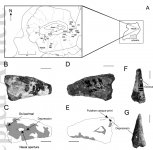Fred Ruhe
Well-known member

Ségolène Riamon, Martin Pickford, Brigitte Senut & Antoine Louchart, 2020
Bucerotidae from the early Miocene of Napak, Uganda (East Africa): The earliest hornbill with a modern‐type beak
Ibis. in press. doi:10.1111/ibi.12907
Abstract: https://onlinelibrary.wiley.com/doi/10.1111/ibi.12907
Hornbills (Bucorvidae and Bucerotidae) are among the most recognizable groups of birds. Their large, curved beak topped by a casque is their most obvious feature. Here, we describe the earliest fossil of a hornbill and more precisely a Bucerotidae, from the early Miocene of Napak. This fossil is a proximal part of a maxilla that can be tentatively assigned to the genus Tockus and which attests to an ancient evolutionary origin of this particular beak shape. The new fossil, as well as several postcranial bones, represent the earliest record of the Bucerotidae dated to about 19 million years ago, and can serve as a calibration point in future molecular phylogenies.
Enjoy,
Fred
Bucerotidae from the early Miocene of Napak, Uganda (East Africa): The earliest hornbill with a modern‐type beak
Ibis. in press. doi:10.1111/ibi.12907
Abstract: https://onlinelibrary.wiley.com/doi/10.1111/ibi.12907
Hornbills (Bucorvidae and Bucerotidae) are among the most recognizable groups of birds. Their large, curved beak topped by a casque is their most obvious feature. Here, we describe the earliest fossil of a hornbill and more precisely a Bucerotidae, from the early Miocene of Napak. This fossil is a proximal part of a maxilla that can be tentatively assigned to the genus Tockus and which attests to an ancient evolutionary origin of this particular beak shape. The new fossil, as well as several postcranial bones, represent the earliest record of the Bucerotidae dated to about 19 million years ago, and can serve as a calibration point in future molecular phylogenies.
Enjoy,
Fred




